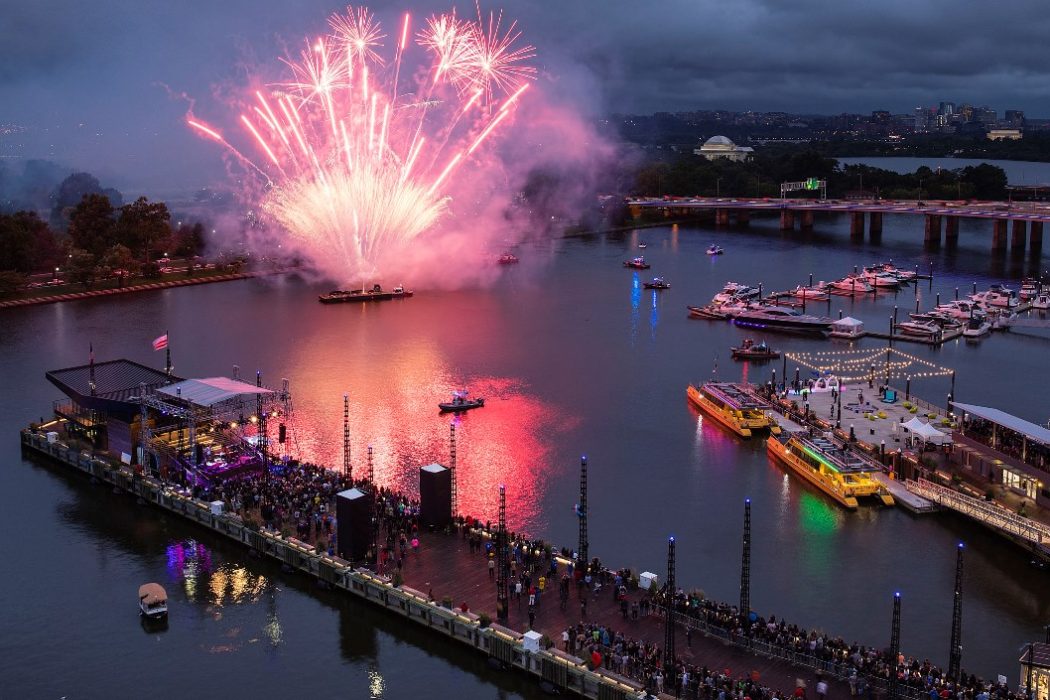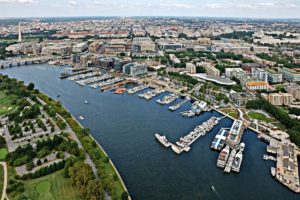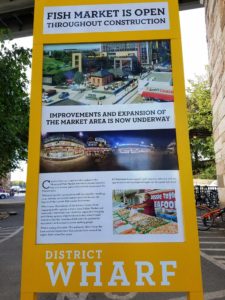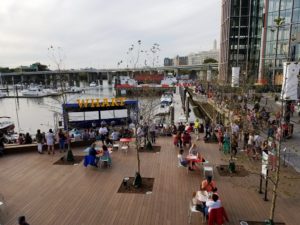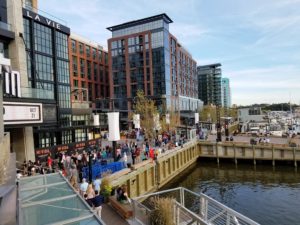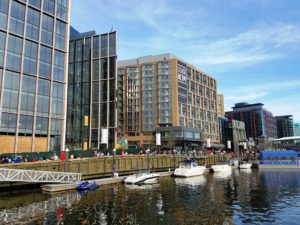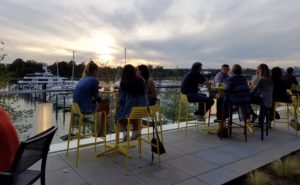On October 12, 2017 something happened that I (Storm) and millions of other DC-area residents have long awaited. Phase 1 of The Wharf opened to the public.
In the process, it reactivated a tired, sad stretch of badly-planned waterfront, and reestablished Washington, DC as a true waterfront city and destination.
I was happy to see the large amount of residential capacity. Too many waterfront developments (especially those done by “new urbanists”) turn out to be sterile and hyper-commercial, with only a bare minimum of residences.
As anyone who has heard one of my talks or workshops knows, the three most powerful “universal” revitalizers are water, residents, and transit. The Wharf boasts ample quantities of all three.
Transit-wise, The Wharf enjoys:
- 5 Metro lines and a Virginia Railway Express (VRE) station within easy walking distance;
- 10 minutes by car to National Airport and Union Station;
- 2500 automobile parking spaces;
- 1150 bike parking spaces;
- 1/2 mile of dedicated bike path;
- 4 Capital Bikeshare stations;
- 4 stops on the new regional water taxi service connecting The Wharf to Georgetown, Virginia, and Maryland;
- Free Southwest Neighborhood Shuttle bus servicing The Wharf, L’Enfant Plaza, and the National Mall; and
- Free Wharf Jitney boat service to East Potomac Park (another favorite feature of mine).
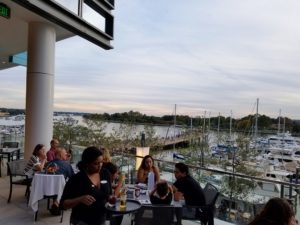
South Potomac Park is across the water, and a new free water jitney takes Wharf visitors to it from the pier you see here (a long-needed connection). Photo: Storm Cunningham
The $2.5 billion, 3.2 million square foot waterfront neighborhood features new residential, office, hotel, shops and restaurants, cultural, marina, and public uses, including 10 acres of public waterfront parks, promenades, piers, and docks, all designed by one of the most impressive lineups of architects in the nation.
The mix of uses offers something for everyone, with an incredible mix of best-in-class brands, local favorites and renowned chefs and shops.
The Wharf is the largest waterfront development in the nation and the first significant redevelopment in Southwest D.C. in more than 50 years, drawing inspiration from waterfronts around the world and designed to bring the community to the water’s edge.
Another aspect of this massive revitalization effort is that the shabby-but-much-beloved fish market is being sensitively renewed. Many locals were holding their breath, having been traumatized by power-crazed urban planners in the past.
For instance, decades ago, planners tried to tear down the gorgeous Old Post Office (now a Trump Hotel) just because it didn’t match the other buildings in the Federal Triangle master plan. As a result, we were half expecting them to take a similar tabula rasa approach to the fish market. More intelligent, sensitive heads apparently prevailed.
The Wharf impacts the region in many ways from generating funding and employment opportunities, creating sustainable infrastructure, incorporating public spaces, reconnecting people to the waterfront, and making the region more accessible. Built as a public-private partnership that began more than a decade ago, this monumental waterfront neighborhood opens with a six-month long celebration of events and public activities, which began with a four day celebration on October 12-15, 2017.
During the Kickoff Celebration Weekend on October 12-15, The Wharf hosted free concerts on three outdoor stages and strolling entertainment, art exhibits and more, with more than 50 entertainers. The headlining event was a free, public concert on District Pier with one of my favorites, The Bacon Brothers, the folk rock soul country band made up of award-winning actor and singer Kevin Bacon and his brother, Michael.
Through the construction of The Wharf there has been an expansion in the usage of the waterfront from a previously private, fenced off boat parking lot to an active harbor with public access across the entire site in addition to upgrades made to all existing facilities.
The Wharf introduces stunning community spaces including public parks and four public piers, which offer seating, event spaces, firepits, swings, public kayak launch, transit options, as well as seasonal uses like ice skating, in addition to ongoing public events and programming.
“After working more than a decade to make The Wharf a reality,we are honored to open this incredible, thriving waterfront neighborhood to the public,”says Monty Hoffman, Founder and CEO of PN Hoffman. “The Wharf is a world-class destination that offers something for everyone, from music to great food and drinks, many ways to connect and play on the water to phenomenal free events at the new parks and piers.”
Here are just a few of the amenities already in operation at The Wharf: Anthem, a concert and events venue with a variable capacity from 2,500 to 6,000 people.
Nearby Pearl Street is a cobblestone, pedestrian-friendly street with bars and innovative food concepts along with live music playing every night from such intimate venues lining the street as Pearl Street Warehouse, Union Stage, and Kirwan’s Irish Pub.
Restaurant offerings at The Wharf include Del Mar de Fabio Trabocchi, Nick Stefanelli’s three-story Italian Market and Restaurant, Requin by Mike Isabella and Jennifer Carroll, Florentijn, Kaliwa by Cathal Armstrong, Mi Vida by Roberto Santibañez, Hank’s Oyster Bar, La Vie, Potomac Distilling Company’s rum distillery, and Rappahannock Oyster Bar.
With 868 residences across four distinct buildings, there is plenty of opportunity to call The Wharf home. From distinctive condos for sale to amenity-rich apartments for rent, these residences offer spectacular views of the Potomac River and national monuments.
The Wharf residences include VIO and 525 Water (condominiums) plus Incanto and The Channel (apartments).
The Wharf offers a one-of-a-kind selection of places for visitors to stay, with iconic views and an easily accessible location to see and explore the sights of the city. Hotels include the first Canopy by Hilton hotel to open in North America, Hyatt House, an extended-stay hotel, and the InterContinental Hotel.
I was especially impressed with the way the Hyatt House designed massive elevated public spaces and dining areas to plumb maximum value from the water and park views.
The Wharf also delivers beautiful and spacious new trophy and Class A offices sitting directly over the water, such as 1000 Maine: 11-story waterfront trophy office building, 800 Maine, an 11-story Class A office building featuring penthouse space for events, and Pier 4, DC’s first and only office building on a pier, sitting directly over the water.
Here’s a recap of the numbers involved in this ambitious and successful redevelopment:
- $2.5 billion of total investment;
- 3.2 million square feet of residential, hotel, office, restaurant, retail, and cultural space;
- 1 mile of waterfront with 24 acres of land and 50 acres of riparian rights in the historic Washington Channel;
- 1375 residences;
- 800 rooms in four hotels;
- 335,000 square feet of restaurant and retail space;
- 945,000 square feet of Class A office space;
- 6000-person-capacity music venue, The Anthem;
- 2,500 parking spots in a below-grade garage;
- 10 acres of parks, open spaces, and civic areas;
- 400 new trees planted on the site;
- 4 public-use piers; and
- 400 boat slips.
Of course, any urban project of The Wharf’s size is going to attract criticism, and The Wharf is no exception. A December 19, 2017 article in Planetizen by Jerrod A. Laber claims that the project has made the city’s affordable housing crisis worse, and that it profited at the public’s expense thanks to political connections. Here’s a brief exceprt from that article: “The average rent in Washington, D.C. is $1,899 a month. The Wharf currently features two separate apartment complexes, with 649 apartments total. The Southwester reports that 131 of those apartments are ‘affordable apartments for households earning 60% and 30% Area Median Income or less.’ That might seem admirable, but the deal developers received from the city government makes it less so.”
Laber’s article continues: “The land that The Wharf sits on was previously public property. Appraisers valued the property worth $95 million. An investigation by WAMU 88.5 found that the city sold the land for $1. The municipal government also distributed an almost $200 million subsidy to developers. The WAMU investigation found further that development teams in D.C. that get the most lucrative land deals are also the largest donors to city officials from their industry over a ten-year period. Ben Soto, the head of one firm involved in The Wharf, is Mayor Muriel Bowser’s campaign treasurer. He was also head of a political action committee that shut down for raising uncapped contributions from individuals who had access to Bowser. Developers deny receiving special treatment.”
Washington, DC has been rapidly climbing out of its long, well-deserved reputation of a place with great wealth, power, and beauty in the center, surrounded by poverty, desperation, and danger in very close proximity. The Wharf is a spectacular example of high-quality developer-driven redevelopment, and is a balance to the citizen-driven revitalization happening not far away at the 11th Street Bridge Project.
Featured photo of opening night fireworks with Bacon Brothers concert by Matthew Borkos / The Wharf.

